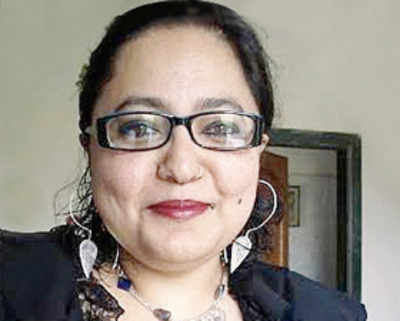Love potion for free India

Paromita Vohra
Where there’s love, voodoo follows. In Shakespeare’s A Midsummer Night’s Dream magic potions bring the gaze of love. Book Seven of the Kamasutra provides love prescriptions involving ingredients as diverse as marigold, laburnum, iron and bovine bile. You can “coat a bamboo flute with a paste of mint, wild ginger, rose-bay, plum, deodar and prickly pear. When played, no woman will resist it.” Aghori Babas have moved up from the pipes of Karol Bagh and walls of Andheri subway to LinkedIn but they are still advertising the oldie but goodie, love problem marriage problem solution.
Whatever its delivery mechanism, the purpose of a love potion was always to entice the beloved. So, when, in a reversal of this order love potions are solicited to repel love - should we surmise that we are in Kalyug?
Given his ulti potion – one that dispels rather than attracts love - Babaji isn’t popular in the youth segment. His fans are primarily parents who drag their daughters to him for a cure.
Bababji’s potion is made of ‘blessed’ mineral water and rice so I am not surprised that many girls refuse to touch this. If the blessing is the main ingredient why not put it on Nathu’s gol gappas? They are also made with mineral water only and the success rate will definitely go up. I mean if you have seen enough Hindi movies then you know that Love between girl and boy usually happens over gol gappas and pani puris so that way he can strike at the root.
What has led to Babaji’s popularity? The renewed panic is over a very old bogey man: Love Jihad. As the historian Charu Gupta has shown in a wonderful study of 19th century moral panic, the idea that Muslim men are seducing, luring away, raping and converting Hindu women has always accompanied a time when relationships of love undergo transformation. 19th century India saw big shifts in women’s lives from reform movements to education. It was also a time when items of pleasure - books, art, recorded music and ultimately cinema - were no longer restricted to the rich, but could be experienced by a growing number of people. The idea of pleasure, desire and personal choice grew and found its most normal expression in elopements, unconventional marriages and a slow visibility of same-sex relationships. Any call for political freedom is surely preceded by a taste of and for personal freedom.
Panic about this freedom resulted in rumours that it was actually caused by the manipulation of Hindu women by Muslim men. Ironocally those wanting freedom from the British, could not give up the idea of controlling their children.
Now too, there’s an explosion of entertainment and mobility, a celebration of life’s sensory aspects and possibilities. Can parents expect their children to take part in the economic fruits and freedoms of the new cultures, travel to study, work and improve their lives materially, but make personal choices which have a 19th century context?
Today, as we celebrate the idea of a free India, we have to celebrate the idea of free Indians too. A new model of Babaji is needed, who defeats the demons of sansanikhez rumours and political manipulations that create rifts between parents and children. The better to embrace change with an open heart, not a narrow mind, helped by a magic potion called Love.
Where there’s love, voodoo follows. In Shakespeare’s A Midsummer Night’s Dream magic potions bring the gaze of love. Book Seven of the Kamasutra provides love prescriptions involving ingredients as diverse as marigold, laburnum, iron and bovine bile. You can “coat a bamboo flute with a paste of mint, wild ginger, rose-bay, plum, deodar and prickly pear. When played, no woman will resist it.” Aghori Babas have moved up from the pipes of Karol Bagh and walls of Andheri subway to LinkedIn but they are still advertising the oldie but goodie, love problem marriage problem solution.
Whatever its delivery mechanism, the purpose of a love potion was always to entice the beloved. So, when, in a reversal of this order love potions are solicited to repel love - should we surmise that we are in Kalyug?
This Kalyug ka love potion can be found in Saharanpur dispensed by Baba Rijakdas who provides cures for Hindu girls only. It’s a zamana of super specialisation, which must explain the narrow scope of Babaji’s operations.
Given his ulti potion – one that dispels rather than attracts love - Babaji isn’t popular in the youth segment. His fans are primarily parents who drag their daughters to him for a cure.
Bababji’s potion is made of ‘blessed’ mineral water and rice so I am not surprised that many girls refuse to touch this. If the blessing is the main ingredient why not put it on Nathu’s gol gappas? They are also made with mineral water only and the success rate will definitely go up. I mean if you have seen enough Hindi movies then you know that Love between girl and boy usually happens over gol gappas and pani puris so that way he can strike at the root.
What has led to Babaji’s popularity? The renewed panic is over a very old bogey man: Love Jihad. As the historian Charu Gupta has shown in a wonderful study of 19th century moral panic, the idea that Muslim men are seducing, luring away, raping and converting Hindu women has always accompanied a time when relationships of love undergo transformation. 19th century India saw big shifts in women’s lives from reform movements to education. It was also a time when items of pleasure - books, art, recorded music and ultimately cinema - were no longer restricted to the rich, but could be experienced by a growing number of people. The idea of pleasure, desire and personal choice grew and found its most normal expression in elopements, unconventional marriages and a slow visibility of same-sex relationships. Any call for political freedom is surely preceded by a taste of and for personal freedom.
Panic about this freedom resulted in rumours that it was actually caused by the manipulation of Hindu women by Muslim men. Ironocally those wanting freedom from the British, could not give up the idea of controlling their children.
Now too, there’s an explosion of entertainment and mobility, a celebration of life’s sensory aspects and possibilities. Can parents expect their children to take part in the economic fruits and freedoms of the new cultures, travel to study, work and improve their lives materially, but make personal choices which have a 19th century context?
Today, as we celebrate the idea of a free India, we have to celebrate the idea of free Indians too. A new model of Babaji is needed, who defeats the demons of sansanikhez rumours and political manipulations that create rifts between parents and children. The better to embrace change with an open heart, not a narrow mind, helped by a magic potion called Love.
Disclaimer: The views expressed here are the author's own. The opinions and facts expressed here do not reflect the views of Mirror and Mirror does not assume any responsibility or liability for the same.













